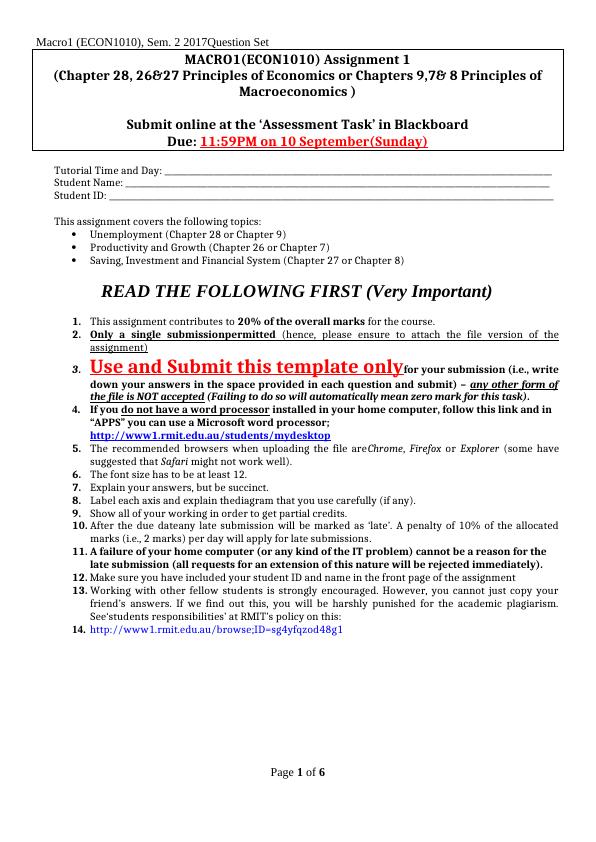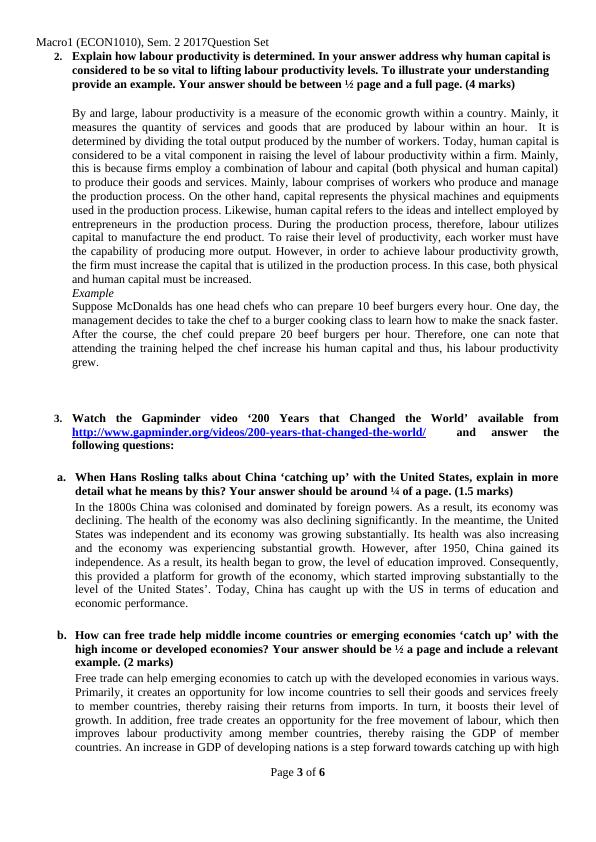Ask a question from expert
MACRO1 (ECON1010) Assignment - Desklib
6 Pages2709 Words226 Views
The University of Queensland
Introductory Microeconomics (ECON1010 Introductory Microeconomics)
Added on 2020-02-23
MACRO1 (ECON1010) Assignment - Desklib
The University of Queensland
Introductory Microeconomics (ECON1010 Introductory Microeconomics)
Added on 2020-02-23
BookmarkShareRelated Documents
Macro1 (ECON1010), Sem. 2 2017Question SetMACRO1(ECON1010) Assignment 1 (Chapter 28, 26&27 Principles of Economics or Chapters 9,7& 8 Principles ofMacroeconomics )Submit online at the ‘Assessment Task’ in BlackboardDue: 11:59PM on 10 September(Sunday)Tutorial Time and Day: _______________________________________________________________________________________________Student Name: ________________________________________________________________________________________________________Student ID: _____________________________________________________________________________________________________________This assignment covers the following topics:Unemployment (Chapter 28 or Chapter 9)Productivity and Growth (Chapter 26 or Chapter 7)Saving, Investment and Financial System (Chapter 27 or Chapter 8)READ THE FOLLOWING FIRST (Very Important)1.This assignment contributes to 20% of the overall marks for the course. 2.Only a single submissionpermitted (hence, please ensure to attach the file version of theassignment)3.Use and Submit this template onlyfor your submission (i.e., writedown your answers in the space provided in each question and submit) – any other form ofthe file is NOT accepted (Failing to do so will automatically mean zero mark for this task).4.If you do not have a word processor installed in your home computer, follow this link and in “APPS” you can use a Microsoft word processor; http://www1.rmit.edu.au/students/mydesktop5.The recommended browsers when uploading the file areChrome, Firefox or Explorer (some havesuggested that Safari might not work well).6.The font size has to be at least 12.7.Explain your answers, but be succinct. 8.Label each axis and explain thediagram that you use carefully (if any). 9.Show all of your working in order to get partial credits.10.After the due dateany late submission will be marked as ‘late’. A penalty of 10% of the allocatedmarks (i.e., 2 marks) per day will apply for late submissions.11.A failure of your home computer (or any kind of the IT problem) cannot be a reason for the late submission (all requests for an extension of this nature will be rejected immediately). 12.Make sure you have included your student ID and name in the front page of the assignment13.Working with other fellow students is strongly encouraged. However, you cannot just copy yourfriend’s answers. If we find out this, you will be harshly punished for the academic plagiarism.See‘students responsibilities’ at RMIT’s policy on this: 14.http://www1.rmit.edu.au/browse;ID=sg4yfqzod48g1Page 1 of 6

Macro1 (ECON1010), Sem. 2 2017Question SetShort Answer Questions:1.Consider a closed economy in which GDP equals $20 billion, consumption equals $13 billion, governmentpurchases equal $3 billon and tax revenue equals $1 billion. Use this information to answer the followingquestions: (3 marks)a. What is private savings equal to in this economy? (0.5 mark)b. What is public savings equal to in this economy? (0.5 mark)c. How would the level of public savings impact the supply of loanable funds? (0.5 mark)d. What is national saving equal to in this economy? (0.5 mark)e. What are net exports equal to in this economy? (0.5 mark)f. What is investment equal to in this economy? (0.5 mark)Page 2 of 6

Macro1 (ECON1010), Sem. 2 2017Question Set2.Explain how labour productivity is determined. In your answer address why human capital is considered to be so vital to lifting labour productivity levels. To illustrate your understanding provide an example. Your answer should be between ½ page and a full page. (4 marks)By and large, labour productivity is a measure of the economic growth within a country. Mainly, itmeasures the quantity of services and goods that are produced by labour within an hour. It isdetermined by dividing the total output produced by the number of workers. Today, human capital isconsidered to be a vital component in raising the level of labour productivity within a firm. Mainly,this is because firms employ a combination of labour and capital (both physical and human capital)to produce their goods and services. Mainly, labour comprises of workers who produce and managethe production process. On the other hand, capital represents the physical machines and equipmentsused in the production process. Likewise, human capital refers to the ideas and intellect employed byentrepreneurs in the production process. During the production process, therefore, labour utilizescapital to manufacture the end product. To raise their level of productivity, each worker must havethe capability of producing more output. However, in order to achieve labour productivity growth,the firm must increase the capital that is utilized in the production process. In this case, both physicaland human capital must be increased. ExampleSuppose McDonalds has one head chefs who can prepare 10 beef burgers every hour. One day, themanagement decides to take the chef to a burger cooking class to learn how to make the snack faster.After the course, the chef could prepare 20 beef burgers per hour. Therefore, one can note thatattending the training helped the chef increase his human capital and thus, his labour productivitygrew. 3.Watch the Gapminder video ‘200 Years that Changed the World’ available fromhttp://www.gapminder.org/videos/200-years-that-changed-the-world/ and answer thefollowing questions:a.When Hans Rosling talks about China ‘catching up’ with the United States, explain in moredetail what he means by this? Your answer should be around ¼ of a page. (1.5 marks) In the 1800s China was colonised and dominated by foreign powers. As a result, its economy wasdeclining. The health of the economy was also declining significantly. In the meantime, the UnitedStates was independent and its economy was growing substantially. Its health was also increasingand the economy was experiencing substantial growth. However, after 1950, China gained itsindependence. As a result, its health began to grow, the level of education improved. Consequently,this provided a platform for growth of the economy, which started improving substantially to thelevel of the United States’. Today, China has caught up with the US in terms of education andeconomic performance. b.How can free trade help middle income countries or emerging economies ‘catch up’ with thehigh income or developed economies? Your answer should be ½ a page and include a relevantexample. (2 marks) Free trade can help emerging economies to catch up with the developed economies in various ways.Primarily, it creates an opportunity for low income countries to sell their goods and services freelyto member countries, thereby raising their returns from imports. In turn, it boosts their level ofgrowth. In addition, free trade creates an opportunity for the free movement of labour, which thenimproves labour productivity among member countries, thereby raising the GDP of membercountries. An increase in GDP of developing nations is a step forward towards catching up with highPage 3 of 6

End of preview
Want to access all the pages? Upload your documents or become a member.
Related Documents
ECON1010- Principles of Economicslg...
|6
|1884
|123
Macro1 (ECON1010) - Assignmentlg...
|7
|3019
|194
Macroeconomics - Assignment Samplelg...
|6
|1807
|212
The Monetary System (Chapter 29 or Chap 29) and Macro1 (ECON1010), Sem. 2 2017 Question Setlg...
|5
|2083
|249
Cost Centre in Different Types of Departmentslg...
|7
|2093
|232
COIT20261 Network Routing and Switching - Assignmentlg...
|6
|1655
|25